City guides

Santo Domingo Travel Guide
If any city in the world could be declared the perfect holiday destination, Santo Domingo would probably be a prime candidate, with its modern sophistication, old world charm and Latin charisma. Its position on the tropical southern Caribbean coast of the Dominican Republic helps too.
Santo Domingo was the first European settlement in the New World and boasts the western hemisphere's first cathedral, first hospital, first university, and first law court. This rich colonial heritage, sparked off in the 15th century by legendary Spanish explorer Christopher Columbus, has been turned into a UNESCO World Heritage Site in the heart of the city. Known as the 'Colonial City', it is now a delightful area of cobblestone streets and 16th-century buildings, interspersed with cafes, bars, small hotels, and restaurants.
Visitors don't need to stray far to enjoy a great time in the city, but it is advisable not to ignore the modern part of Santo Domingo. The superb shopping, delicious dining, dazzling casinos, seductive parks and vibrant nightlife all beckon enticingly, and any opportunity to watch a game of the Dominican Republic's adored national sport, baseball, at Estadio Quisqueya should not be passed up.
Things to do in Santo Domingo
Santo Domigo has an array of historical and natural attractions to suit even the most discerning traveller. Though situated right on the Caribbean Sea, Santo Domingo isn't a beach town. Instead, visitors should spend some time at historically significant sites such as the Catedral Primada de America or the Fortaleza Ozama.
Visitors should also allot an hour or two for the architecturally significant and visually awesome Columbus Lighthouse, which now houses the alleged remains of Christopher Columbus. And then there's the Malecon, which some say is the best nightlife available in the Caribbean.
Whatever a traveller's tastes, Santo Domingo is both big enough to entertain for days and small enough to cover in a solid day of sightseeing and cultural exploring. With plenty of attractions to entertain and amaze for the whole family, the diversity of the city is really shown through various sights, from the natural beauty of the Los Tres Ojos National Park to the historical splendour of the Colonial Zone of Santo Domingo.
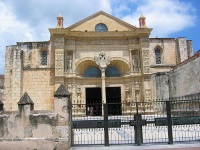
Cathedral of Santa Maria
Inside the Colonial City stands the oldest cathedral in the western hemisphere. Consecrated in 1541, it is still used to this day. Its mix of late-Gothic and Renaissance elements provide a beautiful example of Spanish Renaissance architecture, with its golden coral facade and Gothic interior. Its walls have seen a great deal of history, including the coming of Sir Francis Drake, who captured Santo Domingo in 1586 and held the town for ransom. Interestingly, the remains of Christopher Columbus were once housed at the cathedral, before their final resting place in the Faro a Colon. The cathedral's treasury has an excellent art collection of ancient woodcarvings, furnishings, funerary monuments, silver, and jewellery, which visitors can explore.
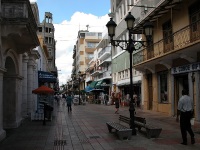
Colonial City
Known as the Colonial City, the historic enclave of Santo Domingo covers only one square mile (3 sq km), but has dozens of historical sites and buildings behind its walls. Visitors will find parks, forts, churches, plazas, statues, palaces and monuments. A walking tour of these fascinating buildings takes at least three hours, and proceeds over cobbled streets where Christopher Columbus, Fernando Cortez and Francis Drake once walked. The city's main street, Calle de Las Damas, is the oldest street in the New World. Regarding sights, must-sees include the House of Cord, which is the oldest European building in the Americas, and the Alcazar Palace, where Christopher Columbus' son Diego once lived. It was built between 1510 and 1514.
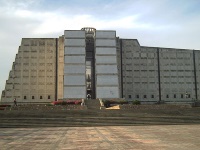
Columbus Lighthouse Monument
The monument was built on the eastern shore of the Ozama River in the early 1990s, to commemorate both Santo Domingo's status as the oldest European city in the Americas, and the 500th anniversary of Columbus' arrival in the New World. The building is 680 feet (210m) long, and built in the shape of a cross. It houses what are claimed to be the remains of Columbus himself, and is fitted with intense lights that project the image of the cross into the sky at night. The monument was designed by Scottish architect J.L. Gleave, who won an international competition with his plans for the lighthouse.
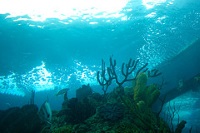
National Aquarium
One of the better aquariums in the Caribbean lies about a mile east of the Columbus Lighthouse monument, and offers visitors guided glimpses of the region's diverse, colourful sea life. The open, airy National Aquarium is equipped with a clear-glass sea-tunnel that makes viewing the enclosed sea life an awesome experience. Visitors can see everything from angelfish to sharks. The attraction is just a short drive out of the city.
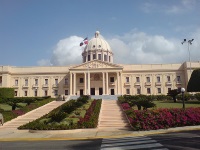
Plaza de la Cultura
The vast green square in the heart of Santo Domingo serves as the city's cultural and artistic showcase. It's fronted by a cluster of four museums and houses the city's most important cultural venues, including the Teatro Nacional (National Theater). The square also boasts the likes of the Palacio Nacional, which houses the Presidency of the Dominican Republic; the Palacio de Bellas Artes (Palace of Fine Arts), a neoclassical building that is the permanent home of the country's National Symphony Orchestra; and the Boulevard 27 de Febrero, a pedestrian promenade located on the busy Avenida 27 de Febrero, which displays works of art from prominent Dominican artists and sculptors.
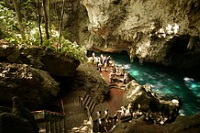
Los Tres Ojos National Park
Located on the east bank of the Ozama River, the 'Three Eyes' park is a surreal experience for visitors. The attraction is actually a series of huge natural caves that contain fresh-water lagoons. One is a sulphuric lake rumoured to be bottomless. A volcanic crater contains it. The caves are also festooned with stalactites and stalagmites. History lovers should note that the pre-Columbian Taino Indians used the caves for religious ceremonies. The site is currently one of the most-visited tourist attractions in the country.
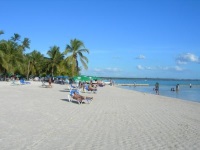
Boca Chica
The small seaside town of Boca Chica lies just east of Santo Domingo on the Avenida de las Americas, and is a popular escape from city life. Its calm, crystal-clear waters make for superb swimming conditions, and its golf and seafood scenes are highly recommended. Visitors may also enjoy the destination's yacht clubs. Along with its azure waters and pristine white sands, Boca Chica's short distance from the island's capital city makes it the most popular beach in the Dominican Republic, especially on weekends and holidays. Boating visitors can anchor off Boca Chica's two islets, La Piedra and La Matica.
Getting Around
Buses run along major routes throughout the city but are not a popular mode of transport for tourists as the system can be confusing. Taxis operate across the city, although not all taxis are clearly marked and they are not normally metered. Travellers should remember that taxis usually operate according to set fares depending on the distance travelled, and should confirm this with the driver before getting in the vehicle. It's recommended that visitors call a taxi dispatcher to arrange a taxi beforehand rather than hailing a taxi directly from the street.
Shared minivan taxis (publicos) are popular among locals. These follow major routes around the city, but don't have specific stops, rather stopping when a passenger flags them down using hand signals. Although they're relatively cheap, they can be quite uncomfortable due to overcrowding. Visitors can hire cars, though self-driving is not always the best option due to poor roads and erratic driving conditions. Uber is available in Santo Domingo.
Santo Domingo Climate and Weather
Santo Domingo has a tropical wet climate. Temperatures remain constant throughout the year, with temperatures averaging between 67F (15C) and 70F (27C). Due to its location on the Caribbean, Santo Domingo is prone to tropical storms, particularly from August to October, so travel during these months should be carefully considered. The best time to visit Santo Domingo is during the drier months from November to March when temperatures are also slightly cooler.
Dominican Republic travel info
Electricity
Electrical current is between 110 and 120 volts, 60Hz. American-style two-pin flat blade plugs are standard.
Language
Spanish is the official language, but English is spoken in the main tourist centres.
Money
The currency is the Dominican Republic peso (DOP), which is divided into 100 centavos. Many of the hotels and restaurants in the main tourist destinations display their prices in US dollars as well as in Dominican pesos, as US dollars are widely accepted. Some places will also accept euros.
Major credit cards are accepted everywhere, but a commission is usually charged. It's recommended that travellers use their credit cards at their hotels, as fraud incidents have been reported. The best exchange rates are paid on US dollars in cash, and are best exchanged at exchange bureaux (casas de cambio). Banking hours are Monday to Friday, 8.30am-4.30pm. Some banks also open on Saturdays. ATMs are widespread.
Tipping
Hotels and restaurants generally include a 10 percent service charge as well as tax, but additional tips should be given for good service, as the charge often does not go to the staff who provided the service. Waiters usually receive 10 percent extra for good service. For other services, including taxi drivers, tipping is discretionary depending on the service provided.
Health
Proof of yellow fever vaccination is required if travellers are over the age of one and are arriving from the states of Mina Gerais, Espirito Santo, Sao Paulo or Rio de Janeiro in Brazil. Proof of yellow fever vaccination is also required of travellers who have transited for more than 12 hours through an airport in those same states.
Precautions are recommended against hepatitis A, typhoid, rabies and polio for those who plan to spend time outside the main tourist resort areas, and travellers heading to certain parts of the country should take prescription medication to prevent malaria. Between May and September there is a risk of dengue fever, which is contracted from mosquitoes that bite during the day, so it is advisable to use mosquito repellent.
Travellers should rely on bottled water in undeveloped areas, as other sources of water will potentially be contaminated, and some species of fish, including tropical reef fish, may be poisonous to eat even when well cooked. There are good hospitals and other private medical facilities located in Puerto Plata, Santiago and Santo Domingo, but facilities are limited outside of these cities, and the staff are unlikely to understand English. Most resorts have doctors that can treat minor medical complaints. Health insurance, including provision for medical evacuation, is recommended.
Safety
Though most visits to the Dominican Republic are trouble free, travellers should not ignore the crime rate. Incidences of violent crime are infrequent but it's worth taking normal precautions against petty crime. Travellers should also check the situation before venturing to the Haitian border, as tensions in the region sometimes flare up. The Dominican Republic is vulnerable to hurricanes from June to November.
Local customs
Being polite to others and having respect for elders is integral and is expected from visitors. If taking a photograph of a local, tourists should ask permission first and then offer a gift afterwards. Dominicans take care in their appearance and form judgements based on what people wear; they are likely to look down on tourists that are unkempt or wear clothes that are too revealing.
Doing business
Good working relationships are vital and trust is an integral part of doing business in the Dominican Republic, as knowing the right people is half the battle won. Appearances are considered important so dressing smartly is advised. Meetings are initially rather formal and a polite greeting accompanied by a handshake is common practice. Punctuality is important, as is courtesy. Business cards are usually exchanged on introduction and it is useful to have all business material printed in English and Spanish, even though English is widely spoken and understood. Business hours are usually 8am to 12pm and 2pm to 6pm, Monday to Friday.
Duty free
Travellers to the Dominican Republic over 16 years do not have to pay duty on 200 cigarettes, 1 litre of alcohol and gifts up to a maximum value of $100.
Communications
The international access code for the Dominican Republic is +1, as with the US, Canada and most of the Caribbean, followed by 809 or 829. The outgoing code is 011 followed by the relevant country code (e.g. 01144 for the UK) but this is not required for calling North America. WiFi is generally available in most cafes, hotels and restaurants.
Passport & Visa
A return or onward ticket is required by all visitors, as is the travel documentation needed for their next destination. It is highly recommended that travellers' passports have at least six months' validity remaining after the intended date of departure from their travel destination. Immigration officials often apply different rules to those stated by travel agents and official sources.
Entry requirements
US citizens must have a passport valid for period of intended stay in the Dominican Republic. A visa is not required for touristic stays.
British citizens must have a passport valid for period of intended stay in the Dominican Republic. A visa is not required for holders of British passports endorsed 'British Citizen' or 'British Overseas Territories Citizen' travelling as tourists. Visitors are required to obtain a Tourist Card on arrival; these are generally valid for 30 days, but can be extended. Holders of passports with any other endorsement should contact the relevant embassy to confirm entry requirements.
Canadian citizens must have a passport valid for period of intended stay in the Dominican Republic. A visa is not required for tourist stays.
Australian citizens must have a passport valid for period of intended stay in the Dominican Republic. A visa is not required for those travelling as tourists.
South African citizens must have a passport valid for period of intended stay in the Dominican Republic. A visa is not required for those travelling as tourists.
Irish citizens must have a passport valid for period of intended stay in the Dominican Republic. A visa is not required for those travelling as tourists.
New Zealand citizens must have a passport valid for period of intended stay in the Dominican Republic. A visa is not required for those travelling as tourists.
Useful contacts
Ministry of Tourism: www.godominicanrepublic.com
911 (General Emergency Helpline)Embassies / consulates in other countries
Embassy of the Dominican Republic, Washington DC, United States: +1 202 332 7670.
Embassy of the Dominican Republic, London, United Kingdom: +44 20 7262 6856.
Embassy of the Dominican Republic, Ottawa, Canada: +1 613 569 9893
Consulate-General of the Dominican Republic, Sydney, Australia: +61 2 4620 3247
Embassy of the Dominican Republic, Pretoria, South Africa: +27 12 362 2463
Embassies / consulates in Dominican Republic
United States Embassy, Santo Domingo: +1 809 567 7775
British Embassy, Santo Domingo: +1 809 472 7111
Canadian Embassy, Santo Domingo: +1 809 262 3100.
Australian High Commission, Port of Spain, Trinidad and Tobago (also responsible for Dominican Republic): +1 868 822 5450
South African Embassy, Havana, Cuba (also responsible for Dominican Republic): +53 7204 9671


